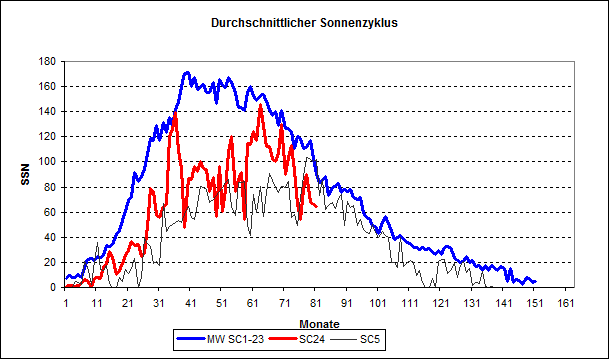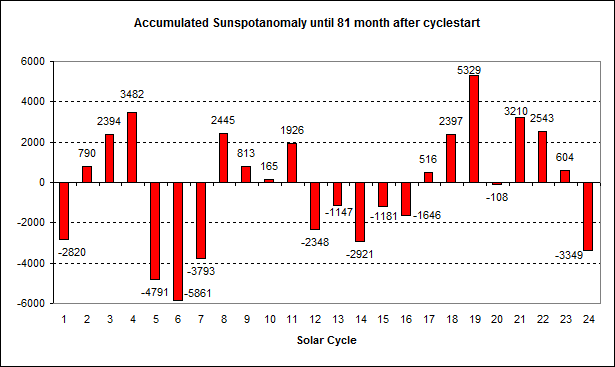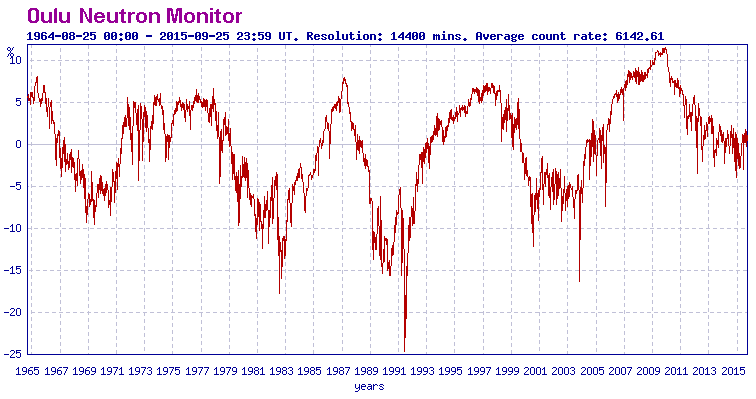The sun in August 2015 and the climatic UV amplifier in the stratosphere
By Frank Bosse and Fritz Vahrenholt
(Translated/edited by P Gosselin)
In August 2015 solar activity was also weak, only 71% of the mean activity that is usual for this month into the cycle. The solar sunspot number (SSN) was 64.6. The mean for the previous 23 cycles is 91. The course of the current cycle so far is depicted in Figure 1:

Figure 1: The solar sunspot number (SSN) for the current solar cycle number 24 is shown in red; the average of the previous 23 cycles is shown in blue; and the similar solar cycle number 5 is shown in black.
The current cycle increasingly resembles solar cycle no. 5, which took place from 1798 to 1810, i.e. in the middle of the Dalton Minimum. That cycle was very long at 12.6 years, which is what we are expecting for the current cycle. As a rule weak cycles are longer than the cycles that see strong solar activity. The summed up monthly anomalies, i.e. the accumulated monthly differences for the current cycle compared to that of the mean value shown by the blue curve in Figure 1, has been the most negative since the Dalton Minimum.

Figure 2: The accumulated SSN anomalies plotted for all cycles 1-24 compared to the mean. The decline in solar activity since cycle no. 22 (which persisted until 1996) is clear to see.
At this blog we reported on a number of occasions on the relationship between solar activity and the North Atlantic Oscillation (NAO). Already in our book “The Neglected Sun“ we quoted a paper by Lockwood who found a strong statistical correlation between solar activity, the NAO and cold British winters. Many other studies have since appeared and further confirm this correlation for Northern Europe. As a reminder: The NAO is calculated as the atmospheric air pressure difference between Reykjavik and the Azore.
In September 2015 another paper was published by scientists Katja Matthes and Remi Thieblemont of the Geomar Center for Ocean Research, appearing in Nature Communications. According to their findings the North Atlantic Oscillation lags solar activity by 1 to 2 years. The scientists used a climate model that simulated the atmosphere at an elevation of up to 14o km and thus were able to better account for the effect of UV radiation on the chemistry of the stratosphere, like ozone composition.
Naturally we know that we have to be careful with the results of models. We’ve documented to a great extent the failure of a huge number of numerical models. What is remarkable, however, is that conventional climate research has since found that the impact of the sun on our climate is relevant. Up to now much effort has been expended to talk down the sun’s impact, claiming that the sun’s total solar irradiance (TSI) varies only by about 0.1% during a cycle. But the UV part of the solar radiation spectrum in the stratosphere have huge radiation effects of up 70%! We discuss this in detail in our book The Neglected Sun. In the ozone layer and the ionosphere UV light is converted into warmth and this leads to correspondingly significant temperature changes in the range of several degrees. This warm-up and the increased formation of ozone leads to interrelated mechanisms and changes in circulation in the atmosphere.
Based on ice cores Matthes and Thieblemont could show evidence that years with harsh winters over the northern hemisphere were related to low solar activity (Adolphi et al. 2014). One example are the strong winters that gripped Northern Europe and North America from 2008 to 2010. During those years we found ourselves in a solar minimum.
And when one looks at the development of cosmic radiation since 1984, an increasingly strengthening magnetic field from solar cycle no. 20 (1964-1976) to cycle no. 22 can be seen along with a weakening of cosmic radiation. A reversal of the effect can be seen since solar cycle number 23. Just how large the UV effect or the fluctuating solar magnetic field are on climate is not possible to say at this time. However in the past there is good agreement between the warming phases and high levels of solar activity. The assumption that only CO2 by itself determines the temperature development in this century is in any case very shaky.

Figure 3: Neutron monitor Oulu (Finland) as a measure for cosmic radiation





think the sinking south of the atlantic cold pool like 2009 much better indicator of individual season though over the long haul, sun big player
To me it’s interesting that a number of papers find a close correlation between low sunspot activity and the NAO. There really appears to be something involved with the UV in the stratosphere and temperature variations up there. Check: (Adolphi et al. 2014), link above.
Could you check/correct this sentence please Pierre?
“The accumulated anomaly, i.e. the summation of the monthly differences for the current cycle compared to that of the mean value shown by the black curve in Figure 1, has been the most negative since the Dalton Minimum.”
Thanks Robin. Now fixed! The anomaly compared to the mean (blue curve, and not the black one.
See here:
http://joannenova.com.au/2015/01/is-the-sun-driving-ozone-and-changing-the-climate/
Is this not a little bit of a stretch?
So few sunspots means white chrismas in Europe? Really?
Is it not much simpler to expect the jet stream to change, because the arctic is warming faster than the rest of the globe?
I am sorry, but this ozon theory needs a lot of evidence, to convince anyone who is even slightly sceptic!
SOD,
There is lots of observational evidence to support my ozone hypothesis but weather is highly variable so prediction for any region is unwise on short timescales of less than decades.
Thanks for the reply. My question is simple: The arctic is warming much faster than the rest of the globe. This is a very simple explanation for changes in wind patterns.
The ozone hypothesis is much more complicated.
So why should i accept your hypothesis?
Because you can’t think properly. Why is the arctic warming through the magic of warmunism when the Antarctic does the opposite.
Have you been molested by German propaganda TV in your childhood or what is it with your brainstem?
The Arctic warmed a little faster (now ceased) due to warmer water ingress to the Arctic Ocean. Nothing to do with CO2.
sod 30. September 2015 at 10:44 AM | Permalink | Reply
“Is it not much simpler to expect the jet stream to change, because the arctic is warming faster than the rest of the globe?”
If the arctic warmed faster than the rest of the globe, why does the Antarctis do the exact opposite.
You are again spreading the desinformation of a pseudoscientific propagandistic thievish cult that managed to gain posts in scientific institutes, rotting them from within to absolute uselessness. Or usefulness, to psychopathic wannabe world rulers like Obama.
Gavs Weather Vids winter 2015 update has a fascinating look at a comparison with SC12 and the current cycle, suggesting that we do indeed have some cold winters ahead for Europe. This builds upon some research by Chorley Weather which he mentions earlier in the video which found a correlation between a negative NAO in July and a negative NAO in DJF following (hence cold winter).
https://www.youtube.com/watch?v=MvTb7TxCE0Y
Turtle-hating Australian scientist finds reason for failure of climate models: Great White Sharks decimate sea turtle population, stopping them from eating sea grass, preventing release of carbon locked in sea grass.
http://www.breitbart.com/big-journalism/2015/09/30/climate-change-sharks-can-save-us-now/
Is that the great Sharknado posited by the Gore/GAIA camp?
Next they’ll be claiming that landsharks can help us too
(as does thinkgeek).
I’m more inclined to trust The Old Farmers’ Almanac, Joe Bastardi, that fellow in Bayern(?) with his “weather predicting plant”; basically anyone who uses and learns from
the various cycles, which obviously “the team” doesn’t.
Hope gas prices go down some more – methinks it’s going to
be a COLD winter…please let it be a white Christmas too…
Let’s first wait and see. The last winter had been predicted as a winter-of-doom in Europe. We all know what the result was. Let’s not use the warmists propaganda about doom and gloom otherwise people will start doubting the message(rs).
I’m hoping for an eoncore of the winter of 1962/1963, in particular in Paris from perhaps the end of November until
the middle of December.
(Having said that, I don’t want to see any injuries or deaths from it.)